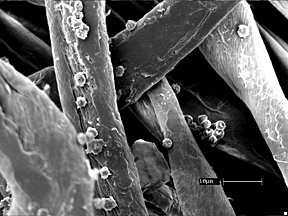Cotton clothes found to be leading carrier of fungal spores, a scourge to some hospital patients with damaged immune systems
By Susan S. Lang

Clothing, particularly cotton, worn by both visitors and patients in hospitals are a leading source of transmission of spores of Aspergillus fungus, according to a study by two Cornell University textile experts. The common fungus has long been known to pose a potentially deadly threat of infection in hospital patients with damaged or impaired immune systems.
Cotton was found to harbor and disperse the spores of Aspergillus more than other fabrics in the study. Aspergillus is a term that refers to a group of airborne mold fungi that are commonly inhaled in all environments worldwide.
Kay Obendorf, professor of textiles and apparel at Cornell and an expert on protective clothing for health-care and agricultural workers, concludes that simply walking into a patient's room can easily dislodge the spores from clothing, with cotton clothes dispersing more than the other fabrics studied. Obendorf examined seven fabric types and suspects other fibers, such as wool, which was not studied, might disperse as much or even more than cotton.
"Hugging, kissing, sitting on a patient's bed or pulling up a chair create air turbulence and friction within and around the fabric, thus releasing potentially deadly spores," she says. However, less than 7 percent of bone marrow units in a national survey conducted by other researchers restrict such activities, Obendorf points out.
As a result, she says, high-risk hospital patients, particularly those suffering from a damaged or impaired immune system, are easily exposed toAspergillus spores. The danger is that they could develop a number of Aspergillus – caused diseases, including pulmonary aspergillosis, a potentially lethal lung infection, Obendorf says.
Obendorf and former Cornell graduate student Betsy Dart, M.S. '98, now a consultant at Arthur D. Little Inc., conducted several studies to determine what role clothing might play in bringing the spores into hospitals. Specifically, they sought to identify textile properties that influence the retention and release of fungal spores on contaminated fabrics. Their work was presented to the American Society for Testing and Materials in Seattle in 1999, and is published in the book Performance of Protective Clothing: Issues and Priorities for the 21st Century (seventh volume, ASTM Society for Testing and Materials 1386, 2000).
Aspergillus spores are very common in all environments, particularly outdoors. Only a few of the molds cause illness in humans and animals. Most people are exposed to these spores daily, but the immune systems in healthy people routinely attack and destroy the spores.
Because the spores are prevalent in the air, soils and on plants, they are easily inhaled. According to some studies, the spores are responsible for as many as 40 percent of deaths among leukemia patients, as well as many deaths among chemotherapy, organ and marrow transplant and AIDS patients, all of whom have weakened immune systems. Once bone marrow transplant patients are infected, the death rate often exceeds 90 percent, according to a report in the Archives of Otolaryngolog y-- Head and Neck Surgery.
Working near a low-traffic area in Cambridge, Mass., the Cornell textile researchers determined that apparel fabrics are easily contaminated withAspergillus spores by outside air. They then tested contaminated swatches of cotton, cotton flannel, polyester, cotton/polyester blend, cotton muslin and rayon chambray to see how the spores disperse on the various fabrics. They also tested how readily the spores remain on or are blown off the fabrics in an airflow chamber.
They found that fiber surface morphology, that is the physical structure of the fiber, is the most important factor in how well the fabric retains and releases spores. Other important factors are moisture content and fabric construction.
In the study, cotton, with its irregular fiber shape, released, by far, more spores than any other fibers, which had smoother surfaces, the researchers report. "Since it's highly likely that hospital staff and patient visitors have worn their clothing outside before entering the hospital and patients' rooms, the potential for exposure via clothing is high," Obendorf says.
Although many hospitals use HEPA (High Efficiency Particulate Air) filters in rooms of patients with compromised immune systems, staff and visitors can easily recontaminate the rooms. According to a national survey of bone marrow units where HEPA filters were used in single rooms, staff were required to wear cover gowns in less than 25 percent of the units, shoe covers in 14 percent and caps in only 4 to 6 percent of the units. Patients were required to gown when leaving their room in 14 percent of the units.
"These practices are inadequate to protect patients from pulmonary aspergillosis," Obendorf concludes. "Despite the cost of gowning, capping and covering shoes, the risk associated with exposure is so high for some patients that the cost is an excellent trade in comparison to the cost and risks of exposure."
The researchers also found that laundering is highly effective in removing the spores. Thus, simply having staff and visitors cover their clothing with hospital–aundered garments and shoe covers before entering patients' rooms would significantly reduce the risk of infection. Such policies, Obendorf says, are currently not pervasive, standardized or enforced. The research was supported, in part, by the National Science Foundation, the College of Human Ecology at Cornell, the Flora Rose Foundation and the American Association of Textile Chemists and Colorists.
Media Contact
Get Cornell news delivered right to your inbox.
Subscribe